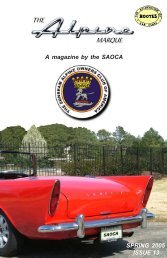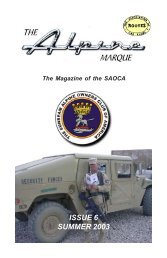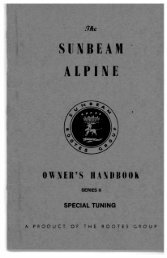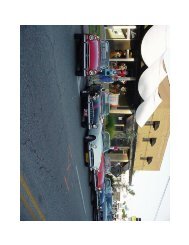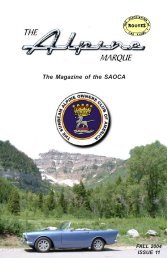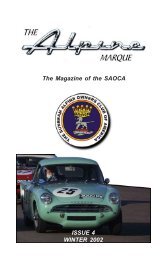The Alpine Marque - The Sunbeam Alpine Owners Club of America
The Alpine Marque - The Sunbeam Alpine Owners Club of America
The Alpine Marque - The Sunbeam Alpine Owners Club of America
You also want an ePaper? Increase the reach of your titles
YUMPU automatically turns print PDFs into web optimized ePapers that Google loves.
THEODOLI’S RUBY: THE 1961 SEBRING HARRINGTON<br />
RACING by David Kellogg ALPINES<br />
Copyright 2002<br />
Racing is a rope whose strands —politics, promotion, and performance—<br />
aggressively vie for attention. With all three in balance and the whole<br />
tightly wound, the result is an even-stranded thing <strong>of</strong> beauty. Racing,<br />
<strong>Sunbeam</strong> and success were intertwined from the start, an artful wea-v-ing<br />
which traded competition success for sales, the ultimate Quid pro quo,<br />
until they bankrupted themselves with ever more exotic racing endeavors.<br />
<strong>The</strong> Harrington stems from this line: it was an aftermarket GT <strong>Alpine</strong>,<br />
which cost more than a Jaguar XKE, with considerably less performance.<br />
Clearly Rootes Group did not learn the lesson <strong>Sunbeam</strong> <strong>of</strong>fered, itself<br />
falling vic-tim to buy-out just as it made its most modern ‘marque,’ the<br />
<strong>Alpine</strong>. This is the story <strong>of</strong> a particular Har-ring-ton and its role in the final<br />
flowering <strong>of</strong> <strong>Sunbeam</strong>’s competition success. And this is an homage to<br />
Rootes and Thomas Harrington Company, Ltd. for having been sufficiently<br />
mad to produce this beguiling car.<br />
A Harrington <strong>Alpine</strong> is a graceful thing indeed. It is an enclosed factory<br />
approved coachbuilt variation on the <strong>Alpine</strong>, smaller than the Aston Martin<br />
DB’s it resembles, more asser-tive in front. <strong>The</strong> tail features an<br />
endearing, abbreviated trunk lid and retains the tall fins <strong>of</strong> the early ‘series’<br />
cars. In pr<strong>of</strong>ile it recalls a distinguished predecessor, the Ferrari 212. All<br />
Harringtons featured a ‘glass fibre’ fastback ro<strong>of</strong> which gave 2" extra<br />
headroom, and luxury interior upgrades in the gran turismo tradition. For<br />
the engine bay, Hartwell <strong>of</strong>fered three stages <strong>of</strong> tune (up to 115 bhp) at<br />
additional expense.<br />
And the Harrington is rare: due to limited produc-tion (approximately 374)<br />
it is little known even in club circles. <strong>The</strong> types —A (108 examples),<br />
LeMans (250) C (12 or 13) and D (4)— are distinguished by styling cues<br />
around the fins, ro<strong>of</strong> line, trunk and exterior trim. Because they were<br />
made to order, most cars had one-<strong>of</strong>f details and trim.<br />
Today’s ‘Beamers rightly see the early nineteen sixties as a heyday<br />
within the golden era <strong>of</strong> <strong>America</strong>n road racing. However, by the time the<br />
‘series’ <strong>Alpine</strong>— was introduced at Earl’s Court in July 1959, <strong>Sunbeam</strong>s<br />
had frequented the winner’s circle for nearly 50 years,when the Rootes<br />
brothers still made bicycles. De-spite limited num-bers, Harrington<br />
<strong>Alpine</strong>s played a disproportionately significant part in com--pe-tition<br />
success, with this Sebring car playing a vital role in the Works Team’s<br />
campaign.<br />
ISSUE #3 <strong>The</strong> SAOC <strong>of</strong> <strong>America</strong> FALL 2002




